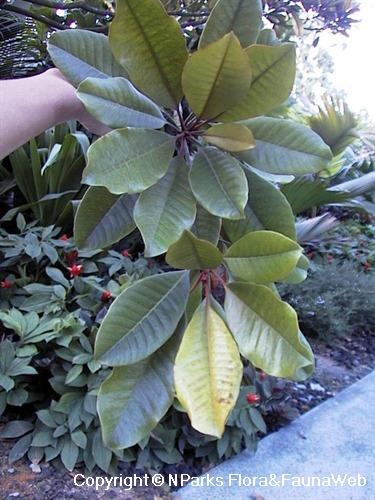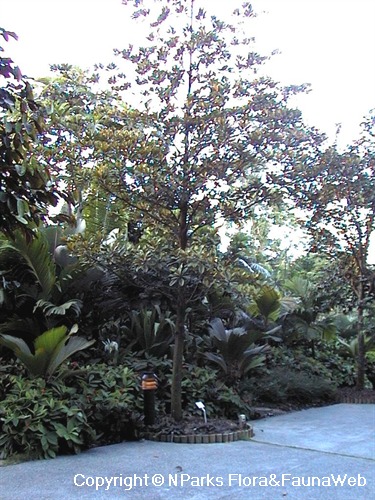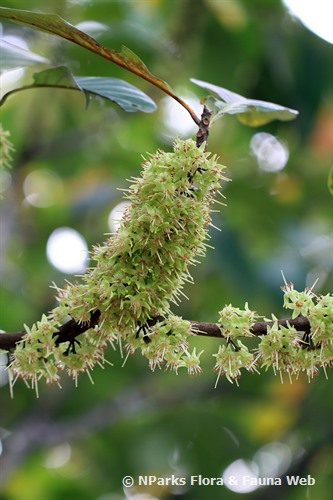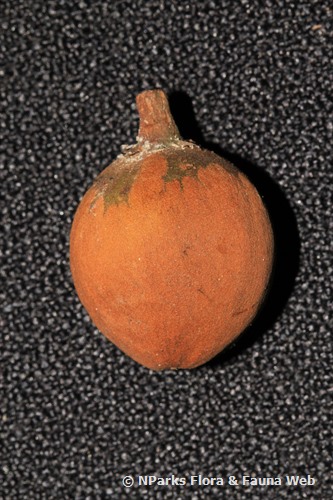
Back
Palaquium oxleyanum Pierre
| Family Name: | Sapotaceae |
| Common Name: | Nyatoh Puteh, Taban Puteh, Getah Cair, Getah Menjatuh, Getah Taban, Getah Taban Cair, Getah Taban Putih, Getah Terban, Taban Putih, Taban Sutera |
Name
Classifications and Characteristics
| Plant Division | Angiosperms (Flowering Seed Plants) (Dicotyledon) |
|---|---|
| Plant Growth Form | Tree (Medium (16m-30m)) |
| Lifespan (in Singapore) | Perennial |
| Mode of Nutrition | Autotrophic |
| Plant Shape | Conical |
| Maximum Height | 24 m |
Biogeography
| Native Distribution | From Thailand to Singapore, and Indonesia |
|---|---|
| Native Habitat | Terrestrial (Primary Rainforest) |
| Preferred Climate Zone | Tropical |
| Local Conservation Status | Native to Singapore (Critically Endangered (CR)) |
Description and Ethnobotany
| Growth Form | It is a tree up to 24 m tall. It is similar to the gutta-percha tree (Palaquium gutta), which has a brownish-green appearance, but differs in its venation, having tertiary veins that are not parallel to secondary veins in the leaves. |
|---|---|
| Foliage | Its alternate, stalked leaves have simple, papery to leathery leaf blades that are elliptic to drop-shaped, 8.1–28 by 2.8–11 cm, not covered with hair and green above, and densely covered with short, fine, brown hair below. |
| Flowers | Its bisexual flowers are about 0.5 cm across, greenish-yellow, and occur in clusters of 3–12 flowers at the leaf axils. |
| Fruit | The fruits are berries that are oblong to round, 2–2.5 by 1.5–2.5 cm, 1-seeded, and covered with short, fine, rusty hair. Its seeds are dark brown, somewhat round to ellipsoid, 1.6–1.8 by 1.3–1.8 cm, and each with a scar covering half of the surface. |
| Habitat | It grows in primary lowland and hill forests. |
| Associated Fauna | Its flowers are insect-pollinated. The fruits and seeds attract bats, which eat and disperse them. |
| Cultivation | It can be propagated by seed. |
| Etymology | Palaquium, from the Filipino vernacular name of the plant, palak-palak; oxleyanum, commemorating Thomas Oxley, a surgeon, who resided where the type specimen was collected on a hill in Singapore |
| Ethnobotanical Uses | Others: This species is harvested mainly for gutta-percha, a kind of latex that is characteristic of its family. |
Landscaping Features
| Landscaping | It may be suitable for parks or roadsides. It is medium-sized and can withstand full sunlight conditions. Its leaves have rusty undersides that are fairly attractive. |
|---|---|
| Desirable Plant Features | Ornamental Foliage |
| Landscape Uses | Suitable for Roadsides, Parks & Gardens |
Fauna, Pollination and Dispersal
| Fauna Pollination Dispersal Associated Fauna | Bat Food |
|---|---|
| Pollination Method(s) | Biotic (Fauna) |
| Seed or Spore Dispersal | Biotic (Fauna) |
Plant Care and Propagation
| Light Preference | Full Sun |
|---|---|
| Water Preference | Moderate Water |
| Plant Growth Rate | Moderate |
| Rootzone Tolerance | Moist Soils, Well-Drained Soils, Fertile Loamy Soils |
| Propagation Method | Seed |
Foliar
| Foliage Retention | Evergreen |
|---|---|
| Mature Foliage Colour(s) | Green, Brown |
| Mature Foliage Texture(s) | Papery, Leathery |
| Foliar Type | Simple / Unifoliate |
| Foliar Arrangement Along Stem | Alternate |
| Foliar Attachment to Stem | Petiolate |
| Foliar Shape(s) | Non-Palm Foliage (Obovate, Elliptical) |
| Foliar Venation | Pinnate / Net |
| Foliar Margin | Entire |
| Leaf Area Index (LAI) for Green Plot Ratio | 4.0 (Tree - Dense Canopy) |
Floral (Angiosperm)
| Flower & Plant Sexuality | Bisexual Flowers |
| Flower Colour(s) | Green, Yellow / Golden |
|---|---|
| Flower Grouping | Cluster / Inflorescence |
| Flower Location | Axillary |
Fruit, Seed and Spore
| Mature Fruit Colour(s) | Brown |
|---|---|
| Mature Fruit Texture(s) | Hairy / Hirsute |
| Fruit Classification | Simple Fruit |
| Fruit Type |
Image Repository
Others
| Master ID | 1756 |
|---|---|
| Species ID | 3049 |
| Flora Disclaimer | The information in this website has been compiled from reliable sources, such as reference works on medicinal plants. It is not a substitute for medical advice or treatment and NParks does not purport to provide any medical advice. Readers should always consult his/her physician before using or consuming a plant for medicinal purposes. |




_lowres.jpg)